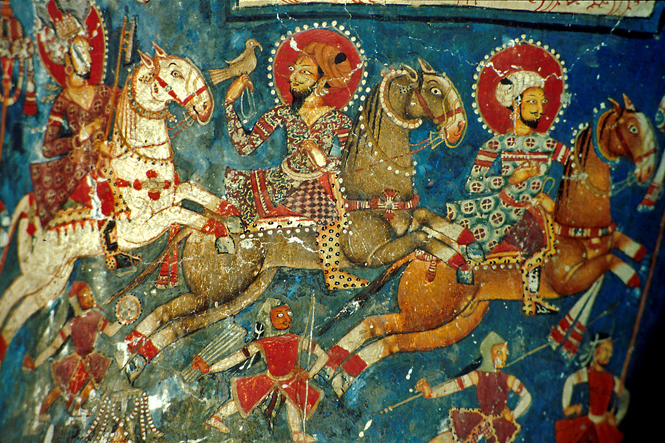-
Chapter 5: PAINTINGS OF INDIA
Introduction
Painting is described as one of the 64 fine arts. Vatsayana described the Shadanga / Six principal limbs of painting:
1. Rupbheda
2. Praman
3. Lavan yojanam
4. Sadrashyam
5. Bhav
6. Varnika Bhang
Indian Paintings
Indian paintings are either Mural or miniature.
Murals
Murals are large works made on the walls of large structures. They flourished during Gupta empire. In Ajanta caves, expressions are shown using hand gestures. Birds and animals are shown in paintings. Frescoes are seen.

Fig 1: Murals of Ajanta Caves
Miniature paintings: Very detailed and small paintings executed on a small scale. They are present on books, cloth or even glass.
Mughal paintings: Indian, Persian and European influence. Mostly miniature paintings are painted. Mughal painting peaked during the period of Jahangir. He was a naturalist and preferred paintings of birds and animals.
Modern paintings: Western influence. Started by Raja Ravi Varma.
Indian Music:
Hindustani and Carnatic music are the oldest music classes in India. Both have their own Gharanas and Sampradayas.
Samveda is the origin of Indian music. Naad is the basis of all creations. Swara, Raag and Taal are basis of Indian music.
Indian Dances:
There are 8 classical dances in India: Bharat Natyam, Kuchipudi, Kathak, Kathakali, Mohiniattam, Sattriya, Odissi, Manipuri.
- Bharat Natyam: Oldest classical dance and it originated in Tamil Nadu. It consists of nritta, nritya, bhava, abhinaya. The Devdasi used to perform these dances.
- Kuchipudi: Andhra Pradesh is the origin. Tarangam is a unique dance with diyas in the hands and vessels of water on the head.
- Kathakali: originates in the state of Kerela. The performance is a combination of five elements like natyam, nritham, nrithyam, geetha and vadyam.
- Mohiniattam: Graceful dance performed only by women. Origin in Kerela.
- Odissi: originates in Orissa.
- Manipuri: originates in Manipur. Movements are subtle and aim is devotion and grace.
- Sattriya: Originates in Assam. Latest classical dance.
- Kathak: Origin in north India. It was revitalized due to influence of Mughals on Indian culture.
Solved Question Papers
Q.Kalamkari painting refers to (UPSC CSAT 2015)
a hand-painted cotton textile in South India
a handmade drawing on bamboo handicrafts in North-East India
a block-painted woollen cloth in Western Himalayan region of India
a hand-painted decorative silk cloth in North-Western India
Ans . A
Kalamkari painting is a type of Indian folk textile art that involves free hand drawing and painting or printing on cloth, mostly cotton. Derived from the Persian language meaning ‘drawing or crafting with pen’, Kalamkari is an ancient form of painting that developed in India over a period of 3,000 years.
Kalahasti and Machilipatnam in Andhra Pradesh, the nerve centres of this art continue to be beehives of Kalamkari activity.
Quiz
Score more than 80% marks and move ahead else stay back and read again!